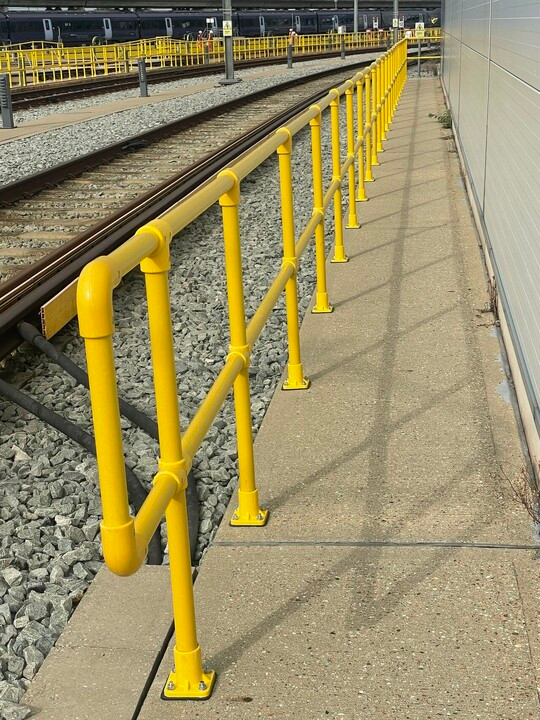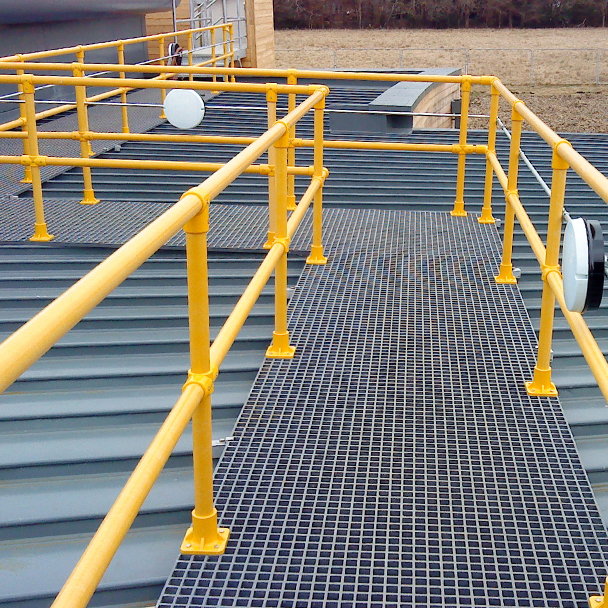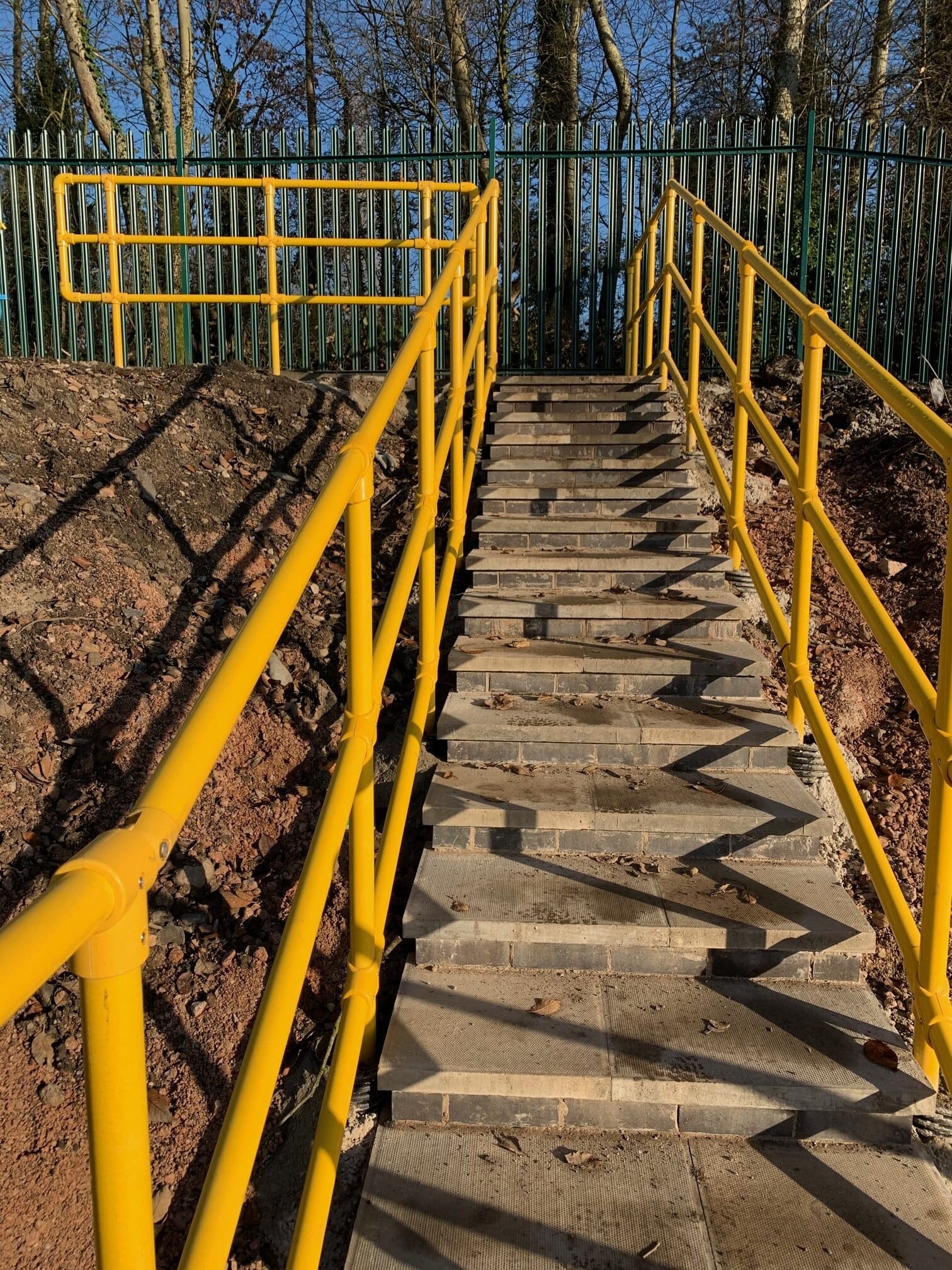FRP Walkways (Fiber-Reinforced Plastic Walkways) are advanced platforms designed for a variety of industrial, commercial, and public infrastructure applications. These walkways are constructed using high-strength fiber-reinforced materials, offering a combination of lightweight, durability, and resistance to harsh environmental factors. Unlike traditional steel or wood walkways, FRP walkways are corrosion-resistant, customizable, and safer for both workers and the environment.
Introducción al rendimiento del producto
This document provides a detailed overview of FRP Walkways, covering their physical properties, specifications, advantages, disadvantages, and common applications.
1. Physical Properties of FRP Walkways
1.1. Lightweight and Strong
-
FRP walkways are significantly lighter than metal alternatives (up to 75% lighter than steel). This reduction in weight makes them easier to transport and install.
-
Despite their lightweight nature, FRP walkways exhibit superior mechanical strength, making them capable of supporting heavy loads without compromising safety.
1.2. Corrosion and Chemical Resistance
-
Highly resistant to corrosion, particularly from saltwater, chemicals, and harsh weather conditions. This makes them ideal for use in marine environments, chemical plants, and other corrosive settings.
-
FRP materials are immune to rust, ensuring longevity even in environments exposed to moisture or chemicals.
1.3. Electrical and Thermal Insulation
-
Non-conductive material, ensuring safety in environments where electrical hazards are present, such as power plants, substations, and telecom towers.
-
Low thermal conductivity, making FRP walkways comfortable to walk on in environments with varying temperatures.
1.4. Fire Resistance
-
Many FRP walkways are available with fire-retardant resins that meet various fire safety standards, such as phenolic and vinyl ester resins, which provide superior fire resistance y low smoke emission.
1.5. Surface Finishes
-
Personalizable anti-slip surface textures are available to improve traction and safety in wet or oily conditions.
-
UV-resistant coatings are often applied for outdoor applications to prevent UV degradation and maintain durability.
2. Specifications and Customization Options
2.1. Standard Dimensions (Customizable)
-
Espesor: Typically available in 25mm, 38mm, and 50mm options, but can be customized for specific needs.
-
Panel Sizes: Common panel sizes include 1m x 1m, 1.2m x 2.4m, or completely customized dimensions.
-
Load Capacities: Can be designed to support varying loads, with common specifications ranging from 500 kg/m² to 10,000 kg/m².
2.2. Types of FRP Walkways
-
Open-Mesh FRP Walkways – Allows for excellent drainage and airflow, often used in outdoor environments or industrial facilities.
-
Solid FRP Walkways – Provides a solid, smooth surface for cleanrooms, medical facilities, and areas that require a smooth walking surface.
-
Modular FRP Walkways – Designed for easy assembly and expansion, ideal for quickly changing layouts in warehouses or factories.
-
Heavy-Duty FRP Walkways – Ideal for extreme load-bearing applications, such as in offshore oil rigs o heavy industrial environments.
2.3. Material Composition
-
Reinforcement Fibers: E-glass, S-glass, and carbon fiber are common materials used to enhance the strength and durability of FRP walkways.
-
Tipos de resina:
-
Polyester Resin: Standard and cost-effective for general-use applications.
-
Resina de éster de vinilo: Highly resistant to chemicals and temperature extremes, ideal for industrial applications.
-
Resina epoxica: Offers the highest mechanical strength, suitable for heavy-duty applications.
-
Resina fenólica: Offers fire resistance, making it suitable for environments requiring fire safety.
-
2.4. Mechanical Properties (Typical Values)
| Propiedad | Typical Value |
|---|---|
| Resistencia a la tracción | 300-800 MPa |
| Resistencia a la flexión | 250-700 MPa |
| Resistencia a la compresión | 300-850 MPa |
| Densidad | 1.7-2.2 g/cm³ |
| Modulus of Elasticity | 25-45 GPa |
3. Advantages of FRP Walkways
3.1. Full Customization
-
FRP walkways can be customized en size, shape, color, surface texture, and load-bearing capacity to meet the specific needs of different industries.
-
Can be designed with cutouts, drainage systems, and handrails, offering maximum flexibility for diverse applications.
3.2. Corrosion Resistance
-
Highly resistant to environmental degradation, making them ideal for use in marine environments, chemical plants, y food processing industries.
-
No need for maintenance related to rust or corrosion, leading to long-term savings in repair and replacement costs.
3.3. Safety Features
-
Anti-slip surfaces ensure high safety standards in wet or hazardous conditions.
-
Non-conductive properties reduce the risk of electrical hazards in sensitive environments.
3.4. Lightweight and Easy Installation
-
Easy to transport and install due to the low weight of the material.
-
Modular design allows for quick and easy assembly without the need for heavy lifting equipment or welding.
3.5. Longevity and Low Maintenance
-
Durable and long-lasting, requiring minimal maintenance.
-
Unlike wood, it does not warp, rot, or degrade, and unlike steel, it does not rust or corrode.
3.6. Environmentally Friendly
-
FRP walkways are recyclable in some instances, reducing waste.
-
Long-lasting and durable, which minimizes the need for replacements and reduces the environmental impact over time.
4. Disadvantages of FRP Walkways
4.1. Initial Cost
-
The initial purchase cost of FRP walkways is generally higher than traditional steel or wood walkways.
-
However, long-term savings in maintenance and durability often offset the initial investment.
4.2. Limited Heat Resistance
-
FRP walkways are not suitable for extreme high-temperature applications, as they may weaken at temperatures above 200°C.
-
For extremely hot environments, alternative materials such as steel may be required.
4.3. UV Degradation (Outdoor Applications)
-
UV-sensitive resins can degrade over time when exposed to sunlight. UV-resistant coatings o resinas are required for outdoor use.
-
Without proper treatment, outdoor applications may experience surface degradation and a reduction in strength.
4.4. Difficulty in Recycling
-
Recycling FRP materials can be challenging due to the nature of the composite material.
-
Although FRP is durable, the disposal or recycling process is more complicated than metal or wood materials.
5. Applications of FRP Walkways
5.1. Industrial Applications
-
Chemical and Petrochemical Plants – FRP walkways can withstand exposure to chemicals, oils, and harsh weather conditions.
-
Steel Mills and Foundries – FRP is non-conductive, making it safe for electrical hazards.
-
Centrales eléctricas – Ideal for substations and areas with electrical systems due to its non-conductive nature.
5.2. Marine and Offshore
-
Docks, Shipyards, and Offshore Platforms – FRP walkways are resistant to corrosion from saltwater and chemicals, making them a popular choice for maritime environments.
-
Offshore Oil Rigs – Provides a durable, low-maintenance alternative to metal walkways in harsh offshore conditions.
5.3. Public Infrastructure
-
Pedestrian Walkways – FRP is widely used in urban areas where safety and environmental factors are paramount.
-
Bridges and Stairs – FRP offers a lightweight and durable solution for pedestrian bridges and industrial stairways.
-
Public Transit Stations – FRP walkways are used in bus stations, train stations, y subways, providing safety and comfort.
5.4. Food and Pharmaceutical Industries
-
Food Processing Plants – FRP walkways are hygienic, easy to clean, and resistant to corrosion, making them suitable for use in food processing and packaging environments.
-
Pharmaceutical Facilities – Used in cleanrooms and pharmaceutical manufacturing areas where cleanliness is critical.
5.5. Electrical and Telecommunications
-
Telecommunication Towers – FRP walkways ensure safe access to high-altitude towers without conducting electricity.
-
Substations and Electrical Installations – Non-conductive properties make FRP walkways ideal for areas with electrical systems.
6. Conclusion
FRP Walkways are a versatile and highly durable solution for industries requiring reliable, corrosion-resistant, and customizable pathways. While the initial cost may be higher than conventional alternatives, the long-term benefits such as low maintenance, longevity, safety features, and adaptability make them an excellent choice for a wide range of applications, from industrial environments to public infrastructure. With their strength, safety, and environmental advantages, FRP walkways offer a cost-effective, sustainable, and safe solution for modern projects.
FRP Walkways
Serie :
Productos principales >solicitud
Industrial Plants and Chemical Factories Offshore Platforms and Marine Environments Water and Wastewater Treatment Facilities Power Plants and Substations Public Transport Stations and Pedestrian Bridges Construction Sites and Warehouses
Nombre de la marca :
TFcompuesto
Nombre del producto :
FRP Walkways
Material :
Fibra de vidrio
Color :
Yellow,Other
Preguntas más frecuentes
P:
What are FRP Walkways?
A :
FRP Walkways are walkways made from fiber-reinforced plastic materials, combining fiberglass and resin to offer strength, corrosion resistance, and lightweight properties. They are used in various industrial, commercial, and public infrastructure applications.
P:
How strong are FRP Walkways?
A :
FRP walkways are designed to support varying loads, with typical capacities ranging from 500 kg/m² to 10,000 kg/m², depending on the material used and design specifications.
P:
Can FRP Walkways be used in outdoor environments?
A :
Yes, FRP walkways are perfect for outdoor use, particularly in environments exposed to moisture, saltwater, and extreme weather conditions. However, UV-resistant coatings may be necessary to ensure long-term performance under direct sunlight.
P:
Are FRP Walkways fire-resistant?
A :
Yes, FRP walkways can be made with fire-retardant resins (such as phenolic or vinyl ester resins) to meet fire safety standards. These materials produce low smoke emissions and are ideal for environments that require enhanced fire safety.
P:
What customization options are available for FRP Walkways?
A :
FRP walkways can be customized in terms of size, shape, color, load capacity, surface texture (e.g., anti-slip), and integrated features like cutouts, drainage holes, and handrails to meet specific application requirements.
P:
Are FRP Walkways suitable for heavy-duty applications?
A :
Yes, FRP walkways are available in heavy-duty versions capable of supporting extremely high loads, making them suitable for environments such as offshore oil rigs, steel mills, and chemical plants.
Otros productos relacionados














